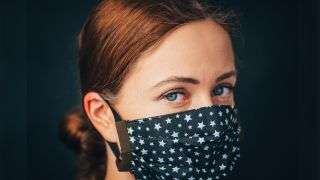
Homemade face masks contain the coronavirus only a little.
For the first time, the Center for Disease Control and Prevention (CDC) has recommended that even seemingly healthy people wear masks over their mouths and noses when venturing out of their homes into places where it is difficult to maintain distance from other people. But there is still major debate over how much masks — particularly the homemade fabric masks that the CDC recommends for the public — can slow the spread of SARS-CoV-2, the virus that causes COVID-19.
Researchers, writing in two new papers, attempt to tackle the efficacy of masks, one more rigorously than the other, and come to differing conclusions. One study examined the effect of masks on seasonal coronaviruses (which cause many cases of the common cold) and found that surgical masks are helpful at reducing how much virus a sick person spreads. The other looked particularly at SARS-CoV-2 and found no effect of either surgical or fabric masks on reducing virus spread, but only had four participants and used a crude measure of viral spread.
The bottom line, experts say, is that masks might help keep people with COVID-19 from unknowingly passing along the virus. But the evidence for the efficacy of surgical or homemade masks is limited, and masks aren’t the most important protection against the coronavirus.
“Putting a face mask on does not mean that you stop the other practices,” said May Chu, a clinical professor in epidemiology at the Colorado School of Public Health on the Anschutz Medical Campus who was not involved in either new study. “It does not mean you get closer to people, it does not mean you don’t have to wash your hands as often and you can touch your face. All of that still is in place, this is just an add-on.”
Face mask basics
Recommendations about masks can easily get confusing, because all masks are not made equal. The N95 mask effectively prevents viral spread. These masks, when properly fitted, seal closely to the face and filter out 95% of particles 0.3 microns or larger. But N95 masks are in serious shortage even for medical professionals, who are exposed to the highest levels of SARS-CoV-2 and are most in need of the strongest protection against the virus. They’re also difficult to fit correctly. For those reasons, the CDC does not recommend them for general use.
Due to shortages, the CDC also does not recommend surgical masks for the general public. These masks don’t seal against the face but do include non-woven polypropylene layers that are moisture resistant. In a surgical mask, about 70% of the outside air moves through the mask and about 30% travels around the sides, Chu told Live Science. For that reason, they don’t offer as much protection as N95s.
That leaves fabric masks, which currently are recommended for general use by the CDC. Fabric masks also allow air in around the sides, but lack non-woven, moisture-repelling layers. They impede only about 2% of airflow in, Chu said.
All of this leakage in surgical and fabric masks are why public health officials generally don’t believe that wearing a mask prevents anyone from catching a virus that is already floating around in the environment. Airflow follows the path of least resistance, said Rachael Jones, an associate professor of family and preventive medicine at the University of Utah who was not involved in the new research. If viral particles are nearby, they have an easy path around a surgical or fabric mask. And in the case of a fabric mask, wearers may well be wafting in particles small enough to flow right through the fabric.
But what about the other way around? When the wearer of a mask coughs or sneezes, the barrier might be enough to contain a lot of that initial jet of grossness — even if there are gaps in the fabric or around the sides. That’s what the new mask studies aimed to address: Whether surgical or fabric masks did a good job of containing viruses.
Efficacy of face masksCoronavirus science and news
—Coronavirus in the US: Map & cases
—What are coronavirus symptoms?
—How deadly is the new coronavirus?
—How long does coronavirus last on surfaces?
—Is there a cure for COVID-19?
—How does coronavirus compare with seasonal flu?
—Can people spread the coronavirus after they recover?
One study, published April 6 in the journal Annals of Internal Medicine, found that they did not. That study, led by South Korean researchers, involved asking four patients with COVID-19 to cough into a petri dish 7.8 inches (20 centimeters) away. The patients coughed without masks, while wearing a disposable surgical mask and again wearing a 100% cotton mask.
Neither mask meaningfully decreased the viral load coughed onto the petri dishes. But experts not involved in the study who were contacted by Live Science were hesitant to put much stock into the findings. The researchers didn’t look at distances beyond 7.8 inches to see if droplets didn’t travel as far while people were wearing masks, Chu said.
“They didn’t measure 2 feet or 3 feet or 4 feet,” she said.
The study also returned the odd result that most swabs from the outside of patient masks were positive for coronavirus and most from the inside were negative. The authors speculate that perhaps turbulent jets of air from coughing carried the virus toward the outside of the mask, but the explanation wasn’t very satisfying, according to Jones.
The other study, published April 3 in the journal Nature Medicine, used a more sophisticated method of collecting the virus particles that sick people emit. The researchers asked 426 volunteers to breathe for 30 minutes into a cone-like device that captures everything exhaled. Of these, 43 patients had influenza, 54 patients had rhinoviruses and 17 patients had seasonal coronaviruses (the kinds that cause colds, not the kind that causes COVID-19). This method allowed the researchers to quantify how much virus was found in droplet particles, which are greater than 0.0002 inches (5 microns) in diameter, versus aerosol particles, which are 5 microns or smaller. The participants were randomized to either wear a surgical mask or not wear a mask during the study.
The first key finding was that the researchers detected virus in tiny aerosol particles in all cases: influenza, rhinoviruses and coronaviruses. In the case of influenza, they cultured the captured particles and discovered that they were infectious. That’s important, said study author Ben Cowling, head of the Division of Epidemiology and Biostatistics at The Hong Kong University, because there is a long-running debate among health professionals about whether influenza can spread via aerosols. The study suggests that it likely can, and that colds probably can too.
“For seasonal coronavirus and rhinovirus, we didn’t attempt to culture the virus in the aerosols, but there is no reason to believe that the virus would not be infectious,” Cowling told Live Science.
And as for masks? Surgical masks reduced the amount of virus released from a sick person in the form of droplets but not aerosols for influenza; the masks reduced coronavirus in both droplets and aerosols; and they didn’t reduce either in rhinovirus. For the seasonal coronavirus, researchers found the virus in droplets in 3 out of 10 samples from participants not wearing masks and in aerosols in 4 out of 10 samples taken without masks. In samples taken with masks, no virus was detected in either droplets or aerosols.
The difference between viruses could have something to do with where in the respiratory tract these infectious invaders make their homes, said Cowling, who is also co-director of the WHO Collaborating Center for Infectious Disease Epidemiology and Control. For example, a virus that reproduces deep in the lungs might need to travel in smaller particles to make it all the way out into the world, while one that reproduces mostly in the nose and throat may be more easily mobilized in bigger droplets.
The results from influenza and seasonal coronaviruses suggest that surgical masks can help keep people with COVID-19 from spreading the virus, Cowling said. SARS-CoV-2 probably behaves similarly to the viruses he and his team studied, he said, and the fact that people can spread the virus before they experience symptoms is an argument for recommending masks for everyone.
But experts are still mixed on the potential usefulness of non-N95 masks.
“To me, it’s not harmful to wear these masks, but it doesn’t look from this study like there is a whole lot of benefit,” Jones said. The sample size for seasonal coronavirus was small, she said, and there was a large amount of non-mask-related variation in how much virus people emitted, particularly given that the majority of samples without masks didn’t have detectable coronavirus.
One thing everyone does agree on is that, whatever containment provided by non-fitted masks do provide, homemade fabric masks are the least effective. The recommendations that everyone wear masks are because “any kind of impediment is better than nothing,” Chu said. But fabric masks are not expected to be as protective as surgical masks, she said. That’s why public health officials are warning people to remain at least 6 feet apart from one another, even if they are wearing masks. In other words, homemade masks are likely to be just a small piece of the puzzle for controlling the COVID-19 pandemic.
“There’s been enough research done to be able to confidently say that masks wouldn’t be able to stop the spread of infection, that they would only have a small effect on transmission,” Cowling said. “We shouldn’t be relying on masks to help us go back to normal.”
- 28 devastating infectious diseases
- 11 (sometimes) deadly diseases that hopped across species
- The 12 deadliest viruses on Earth
Originally published on Live Science.
ABCmouse – 1 Month Free!
The one-month trial gives you access to all of the educational site’s 9,000 activities in reading, science, math and art. Keep your child busy and learning while we are all stuck indoors.
Sourse: www.livescience.com





